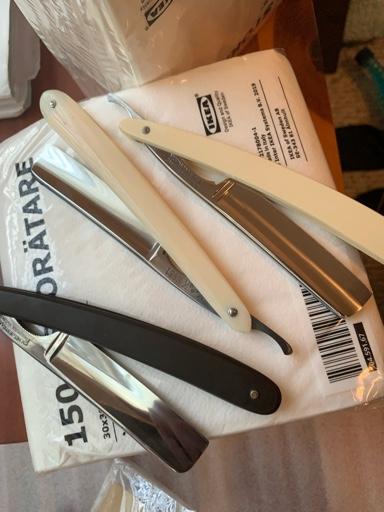- Thread starter
- #141
Thank you for your kindness and for sharing your memoriesGreat post, @Polarbeard. I was just discussing this with my mother and dad recently. I have my paternal grandfather's old razor, a no-frills Geneva Cutlery Inc., which puts its age at around the late 20's based on name changes. Based on his age, it likely was his first razor. Ironically, Dad has no memory of him using it, he used a safety razor for many years, and it had very little hone wear when I got it, and still shaved after a quick strop. Grandpa was clean shaven as long as I knew him, though I believe he had switched to an electric by then. He always had a splash of Old Spice aftershave, though. My dad, on the other hand, has a very tough beard and has worn a beard most of his adult life. In fact he could only get through half his face on one blade! I guess when he switched to Schick blades he could shave his whole face in one go.
My maternal grandfather, on the other hand, shaved most days with a straight razor. Mom was the youngest and her mother had died shortly after she was born, so she spent a lot of time with him as a kid and she has fond memories of watching him go through the ritual of his morning shave. He drove a dray wagon when she was quite young; later he did some kind of business to business sales, so he needed to be presentable.
When I was back home visiting recently mom talked about how much I reminded her of him as she watched me lather up and strop and shave. He was born before the turn of the last century, fought in WWI and was a cleanfaced kid in the one photo I've seen of him in his doughboy uniform before he deployed. I sadly never met him as he died a few years before I was born but mom's cousins all talk fondly of him still.
It turns out I have a lot in common with him that I didn't know about besides just our tonsorial habits. When I was younger and dumber I used to smoke Lucky Strikes. I found out years later that he smoked that brand until the day he died. "And I inhaled every one of them," he used to say. We had similar taste in whiskey, too, mom's cousins tell me. Thing that really got me was last time I was home, I jerry-rigged a filter and a baking funnel to make myself a cup of coffee pour-over style, right into the cup (my folks aren't coffee drinkers). Mom got real quiet and then said, "I haven't seen anyone do that since Daddy was alive. He always made his coffee like that."
Anyway, sorry for the ramble, but thanks for the memories.



